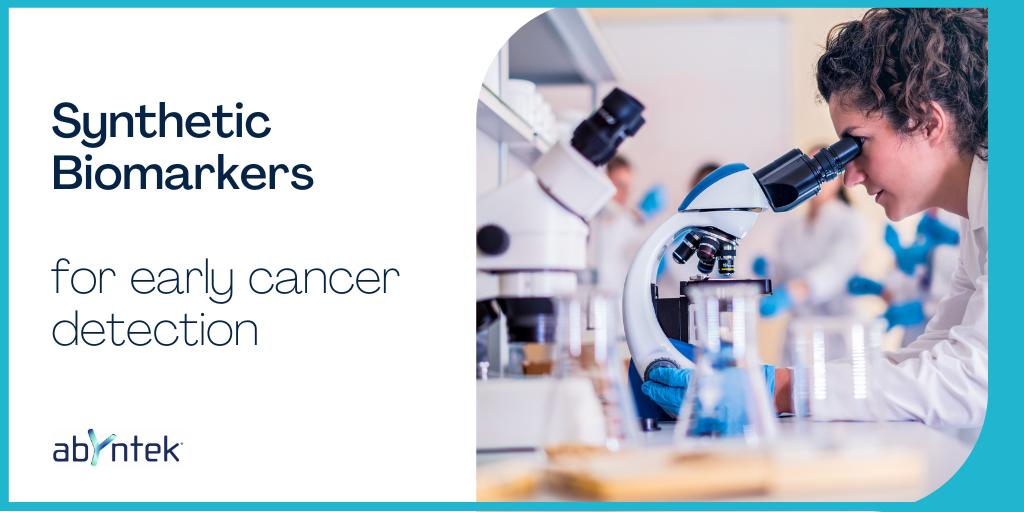The detection of endogenous cancer biomarkers (cell-free nucleic acids, proteins, lipids, metabolites) within blood and urine is a promising strategy for early cancer detection.
At present, prostate-specific antigen (PSA) is the most widespread blood biomarker for prostate cancer, despite its drawbacks. Ideally, a biomarker test should be highly specific to avoid overdiagnosis and hence, overtreatment (as it might occur in screenings with the PSA test). Additionally, biomarkers should also have high sensitivity, so that even very low levels of signals are detected. This aspect is key, as it has been predicted that some tumours could go undetected even after 10 years since tumorigenesis started. Thus, in this case there would be an ample window of opportunity for early detection. On the other hand, fast growing and more aggressive tumours might have a narrower window for early detection and would require even more sensitive biomarkers.
ABYNTEK RESEARCH REAGENTS offers a wide range of high quality bioreagents for cancer research.
To overcome the challenges associated with detection of biomarkers in early stages of disease, such as their short circulation time or their dilution in biofluids, synthetic biomarkers are being developed. Two main approaches might be distinguished (Kwong et al. 2021): activity-based biomarkers and genetically-encoded biomarkers. We briefly describe both approaches below.
1. Activity-based biomarkers
The main characteristic of activity-based biomarkers is that they comprise a sensor component that is activated by enzymes that are present in the tumour microenvironment (TME). The idea is that the enzymatic activity would lead to the amplification of a readout, that is not normally found in the body, facilitating biomarker detection. Below we describe two examples:
Protease activated synthetic biomarkers
Proteases are promiscuous enzymes that are capable of cleaving a variety of substrate sequences. They are implicated in numerous cellular processes, including protein activation, extracellular matrix degradation or apoptosis. In cancer, certain proteases, such as matrix metalloproteinases, have been described to be upregulated and it is thought that they promote angiogenesis.
Protease-activated synthetic biomarkers are based on a peptide substrate that can be cleaved by enzymes present in the TME, leading to the release of a reporter into the blood or urine. The peptide substrate is conjugated to a compatible carrier such as polyethylene glycol (PEG). This system rapidly leads to the amplification of the signal, as a single enzyme can lead to the irreversible cleavage of numerous peptides.
Because a single sensor might not have sufficient specificity for cancer, a more reliable strategy being investigated is to develop a panel of sensors or ´multiplexed library of sensors´ with the aim of identifying a cancer signature. This implies that the reporter obtained upon cleavage of a given peptide can be measured and distinguished from the rest. One approach to accomplish this is by labelling each biomarker with a unique molecular barcode.
An example of this strategy has been recently published by Kirkpatrick et al., 2021. In this study, the investigators have developed a multiplexed panel of sensors that is able to detect early-stage lung cancer in a Kras, Tp53 mutant lung adenocarcinoma mouse model with 92% sensitivity and 100% specificity.
The panel of sensors leverage the activity of 14 proteases that are overexpressed specifically in lung adenocarcinoma to generate urinary reporters. Each sensor was conjugated to a uniquely identifiable mass-encoded reporter (using isotope labelled amino acids), which could be specifically detected by mass spectrometry after the substrate has been cleaved. Thus, this strategy allows a quantitative assessment for each of the reporters liberated in the urine and allowed to discriminate mice with early-stage lung cancer from controls.

Small molecules probes
Small molecule-probes are synthetically designed probes that can sense tumour-associated enzymatic activity. They comprise an enzyme recognition site that is linked to cleavable reporter. Thus, upon systemic administration of the probe, enzymes specifically overexpressed in cancer would cleave the probe generating a synthetic biomarker. Depending on the reporter, the biomarker could be detected by various means. Below we describe two examples of reporters that are being investigated:
One strategy consists in the use of Volatile Organic Compounds (VOCs) as reporters, as these can be analysed and measured in breath. In fact, measurement of VOCs in breath has been implemented in the clinical setting in testing for Helicobacter Pylori (carbon 13 urea breath) or for small-bowel bacteria overgrowth (methane measurement). While efforts have been made to identify a VOC signature for cancer this has not been trivial due to the high variability and low concentration of VOCs. Nevertheless, VOC-based probes have high potential as synthetic biomarkers. In a recent study (Lange et al. 2019), a labelled metabolite of ethanol was used as a VOC-based probe that was converted into D5-ethanol, by the enzyme β-glucoronidase, which is secreted by solid tumours. The reporter, D5-ethanol, diffuses into the plasma and can be monitored in the breath by chromatography coupled to mass spectrometry. The study showed that this synthetic biomarker allowed the discrimination of tumour bearing mice from healthy controls.
2. Genetically encoded biomarkers
Genetically encoded synthetic biomarkers leverage key features of the TME to secrete reporters that can be detected in biofluids. There are three main types: vector-based, mammalian cell-based and bacterial-based sensors. Each type differs from each other in particular tumour-related characteristic or ´input signal´ that is measured and the mode this signal is amplified to allow detection.
Vector-based synthetic biomarkers
They consist on a cancer-selective promoter that can drive the transcription of a synthetic biomarker that can be released into the blood or urine for detection. Systemic delivery of the transgene would result in its expression by the tumour tissue and not by normal cells.
An example of a promoter that could be used in this strategy is that of TERT gene, as TERT is highly expressed in human cancers and silenced in almost all somatic cells. With regards to the secreted reporter transgene, the secreted embryonic alkaline phosphatase (SEAP) and a luciferase named Gluc are two of the most commonly investigated reporters.
The major limitation of these type of sensors is with regards to its delivery to the tumour, as the use of viral vectors in this context is still controversial.
Mammalian cell-based synthetic biomarkers
The rationale of this strategy is to use engineered mammalian cells as a living cellular sensor. The advantage of using the so called ´cell-based diagnostics´ is that some cells are capable of homing and infiltrating certain tumours in contrast to molecular probes, which rely on the vascularization of the tumour or its diffusion capabilities.
In a proof of concept study (Aalipour et al. 2019), macrophages were engineered to encode a synthetic reporter upon their reprogramming to M2 phenotype, which naturally occurs to macrophages within the TME to promote an immunosuppressive microenvironment. This approach used arginase-1 promoter (as ARG1 is highly upregulated upon M2 polarization) and luciferase as a reporter. Upon introduction in breast and colorectal mouse tumour models, the engineered macrophages homed in to the tumour site, activated arginase-1 and consequently started to express luciferase, which was detected both via bioluminescence and in blood.
This method was extremely sensitive, allowing the detection of tumours as small as 25-50 mm3. Nonetheless, the high cost of this approach would not make it suitable as a routine screening tool.
Bacterial-based synthetic biomarkers
The realization that some bacteria can target and selectively infiltrate tumours opened up new strategies for cancer detection based on the use of engineered bacteria that encode particular synthetic biomarkers, under certain conditions only present in the tumour microenvironment.
An advantage of this approach is that the bacteria will expand thereby further amplifying the detection signal. Nevertheless, while the virulence of bacteria used in this approach was diminished, the risk of regaining virulence still constitutes a major safety concern. The field of synthetic biology might provide with some solutions to overcome this current limitation.
To sum up, we have described above various approaches currently being investigated to use synthetic biomarkers for early cancer detection. Some of the current limitations observed in the preclinical studies include on-target off-tumour activation as well as off-target effects.
Additionally, the development of preclinical models that can accurately mimic the early stages of cancer development is essential to asses the efficacy of the synthetic biomarkers being evaluated. Lastly, it is essential that the blood or urine-based synthetic biomarkers can also inform us with regards to tumour localization.
Thus, although there are many other challenges such as tumour heterogeneity or interpatient variations, the field is rapidly advancing and holds promise for new strategies that would allow early cancer detection.
Are you searching for antibodies, proteins or ELISA kits for the study of biomarkers? Check our ABYNTEK RESEARCH REAGENTS catalog, a highest quality bioreagents line that was also born with a vocation for social commitment, allocating part of its sales to Breast Cancer research.
Our technical team will help you to find the product that best suits your research. Contact us here.
References
Aalipour, Amin et al. 2019. “Engineered Immune Cells as Highly Sensitive Cancer Diagnostics.” Nature biotechnology 37(5): 531–39.
Kirkpatrick, Jesse D et al. 2020. “Urinary Detection of Lung Cancer in Mice via Noninvasive Pulmonary Protease Profiling.” Science translational medicine 12(537).
Kwong, Gabriel A et al. 2021. “Synthetic Biomarkers: A Twenty-First Century Path to Early Cancer Detection.” Nature reviews. Cancer 21(10): 655–68.
Lange, Justin et al. 2019. “Volatile Organic Compound Based Probe for Induced Volatolomics of Cancers.” Angewandte Chemie (International ed. in English) 58(49): 17563–66.



